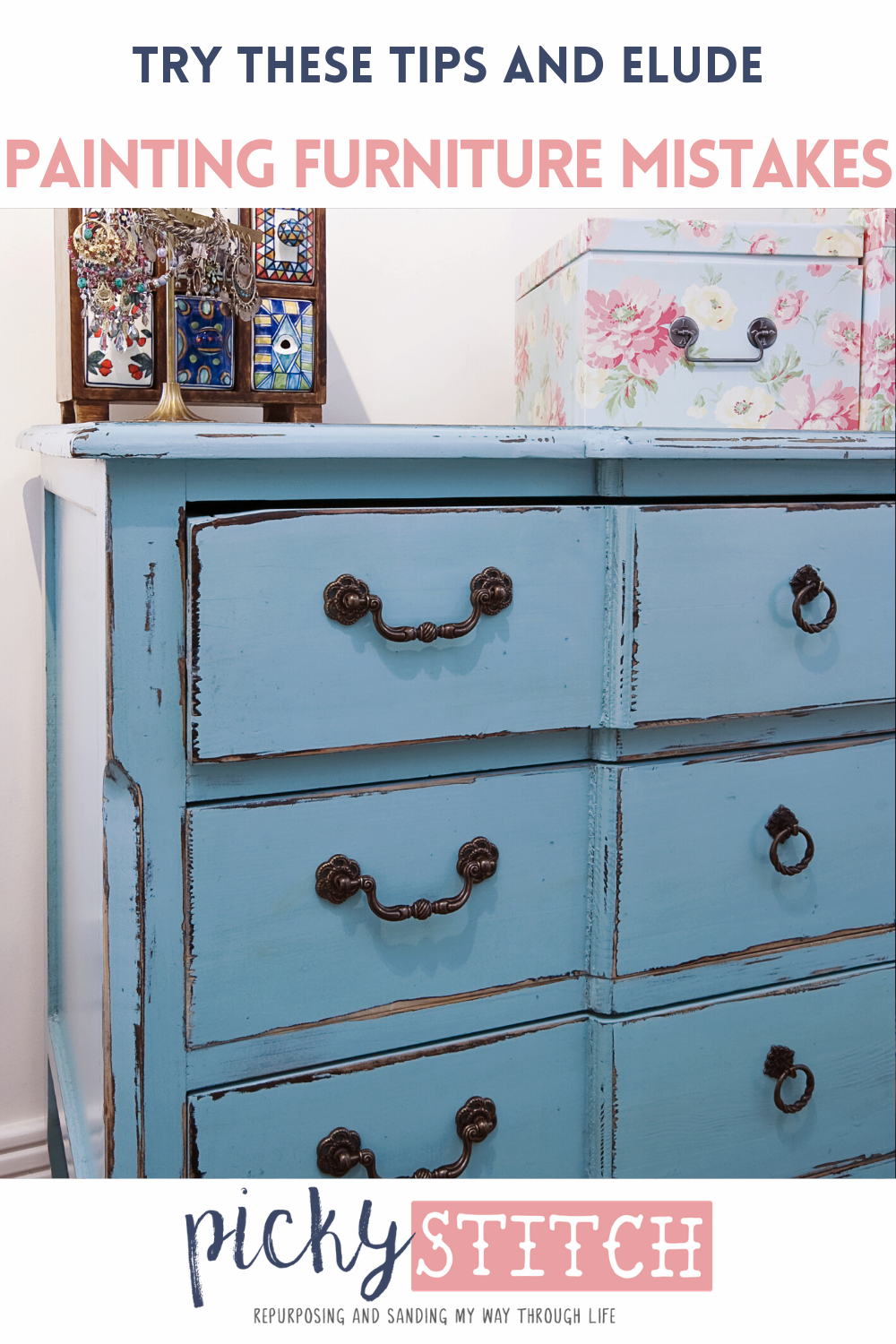Today you will learn about painting furniture mistakes. Painting a piece of furniture is by no means a small task, especially when you don’t know what you are doing! Instead of having to refinish that incredible table you found at the thrift store (again) paint it the correct way the first time!

Painting Furniture Mistakes
Painting Furniture Mistakes: Forgetting to Sand
You’ve read those tutorials. You know, the ones that claim sanding isn’t necessary. There is never a situation in which sanding wouldn’t be necessary (if using latex paint). Roughing up the texture of the furniture gives the primer a surface to stick to, which helps the paint to last much longer!
Remove Residue
Before painting (and after sanding) be sure to wipe down the surface of the piece with a tack cloth. This helps to remove residue, and helps the paint to adhere smooth. Be sure that the cloth used is a tack cloth, using a different kind is not recommended!
Primer is Always Needed
If you are painting laminate furniture, use a shellac based primer. Otherwise, any variety of primer would do just fine. Always apply the primer with a mini roller, and a foam brush (this is good for those hard to reach areas). Once dry, sand away any paint drips and wipe with your tack cloth.
Allowing Adequate Dry Time
Use a mini roller to apply 3 light coats of gloss latex paint. Most people don’t allow enough time in between coats and apply each coat too thick. Be sure to wait at least six to eight hours in between coats of paint. Be sure to sand it down and use a NEW tack cloth to wipe off any lint before moving on to the last step.
Not Applying a Top Coat
Break out a new foam roller to apply a thin coat of water-based protectant. Be sure to go over the piece VERY lightly, so you can smooth out any bubbles that may occur. Allow a 72 hour dry time.
Now that you know what to avoid, you are ready to create a masterpiece. I’d love to see what you create so feel free to post pics in the comment section.
For more furniture painting hacks.
If you want to learn about white washing furniture, here’s your chance.



This was EXTREMELY helpful. I’m a novice at refinishing/painting furniture and am so grateful to have found the mistakes before I made them.
Yes, they say that with chalk paint there is no need to sand but I find that hard to believe. Maybe I am just old school but will lightly sand my furniture before painting, even with chalk paint.
I use chalk paint and only clean the furniture with soap and water before applying the paint and the wax No sanding no primers, no waiting , no fuss, just amazing results.
I do the same thing Gillian does. I have a few pieces of furniture that I used chalk paint on (no sanding or priming) and years later they are still holding up great. Would love some more detail on this…Have you tried chalk paint without sanding and priming? If so, what did you not like about it (compared to a piece that was sanded and primed) or what happened to it that made you say sanding/priming is a must? I’m curious because I’ve had only positive experiences with this process. Thanks!
Maybe it’s just a hard habit to break, but I always sand something down before painting it. When it comes to furniture it’s mainly due to the sealant that is used over the paint to help protect the furniture. Usually when I paint over it, the paint doesn’t stay as well. But I’m glad that you’ve found a process that works for you!
It is absolutely not required to sand furniture before painting it with chalk paint or even latex paint for that matter. Yes, sanding the furniture most definitely helps and makes your job easier in a manner of speaking (time wise that is). I love using the non-toxic paint that Terra Bella sells and a number of other chalk paint products that don’t affect my asthma. In any case, you have to understand the curing process to understand the fact that you don’t have to sand the furniture first. Of course, using a non-toxic product is going to help your cure time. If you are painting a piece of furniture that has not been prepped by sanding it first, then you are going to have to wait, and wait, and wait, but it will cure and it will adhere like nobody’s business. Curing time is not a day or two, not even a week or two. It will take a minimum of 30 days for a newly piece of furniture to cure. The water (and any chemicals) in the paint have to evaporate in order for the paint to cure (harden). If humidity is a factor, it will take even longer. If you added water to your chalk paint, it will take longer. ….and guess what, you can also paint directly on laminate without sanding it first – but good luck with that because it can take months. Shoot, even a newly painted car needs 3 months to cure – I know that we live in a world of convenience but if you want that paint to stay on there – take the time to sand it (or at least scuff or sand off the coated part of the finish first) – but if you don’t want to bother, make sure that you give it time to cure and treat the piece carefully until it does. Also, painting with white chalk paint on old furniture that hasn’t been sanded has the potential to ‘bleed through’ because of all of the oils in the wood from polishing, waxing, etc. and worse yet, nicotene. For the record, I almost never sand unless I am going to stain something and I never clean the furniture first unless it’s dusty. Shoot, I have even painted over oil based products and have gotten the paint to adhere. But do as I say (sand first) and as this article recommends – and not as I do unless you have been doing this for any many moons as I have. Oh and yes, sanding the furniture definitely gives the paint something to grab onto. If you don’t want to sand a laminate piece – apply a very thin ‘wash’ of paint to it first. It will dry quickly and gives you a base coat that provide something for the next coat to grab onto. However, curing time takes forever and it’s way better to sand laminate pieces first. I have done it both ways. One editorial note, please protect yourself when sanding as you are releasing the toxins embedded in the furniture. There’s probably no formaldehyde in an old piece as after about 5 years it has dissipated but there will be other toxins nonetheless. Peace
Whoops, I forgot to comment on the roller and using high gloss latex paint. Only use the roller in one direction. Other wise you will have streaks because you are applying the built in finish of the paint and removing it by going back and forth and it creates an entire host of problems.
Has anyone tried cleaning the piece of furniture with TSP instead of sanding or other methods of preparing?
Rose,
I’ve tried it before! However, it worries me that the mixture is so potent! I’d rather use a little extra elbow grease. Let me know if you like it!